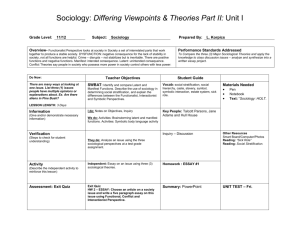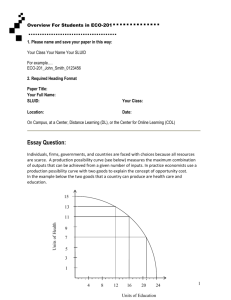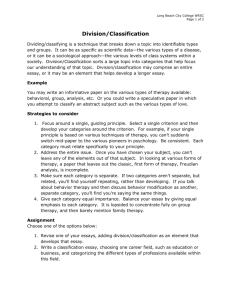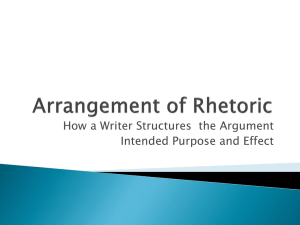Justification, Materials, Assessment, Administration
advertisement
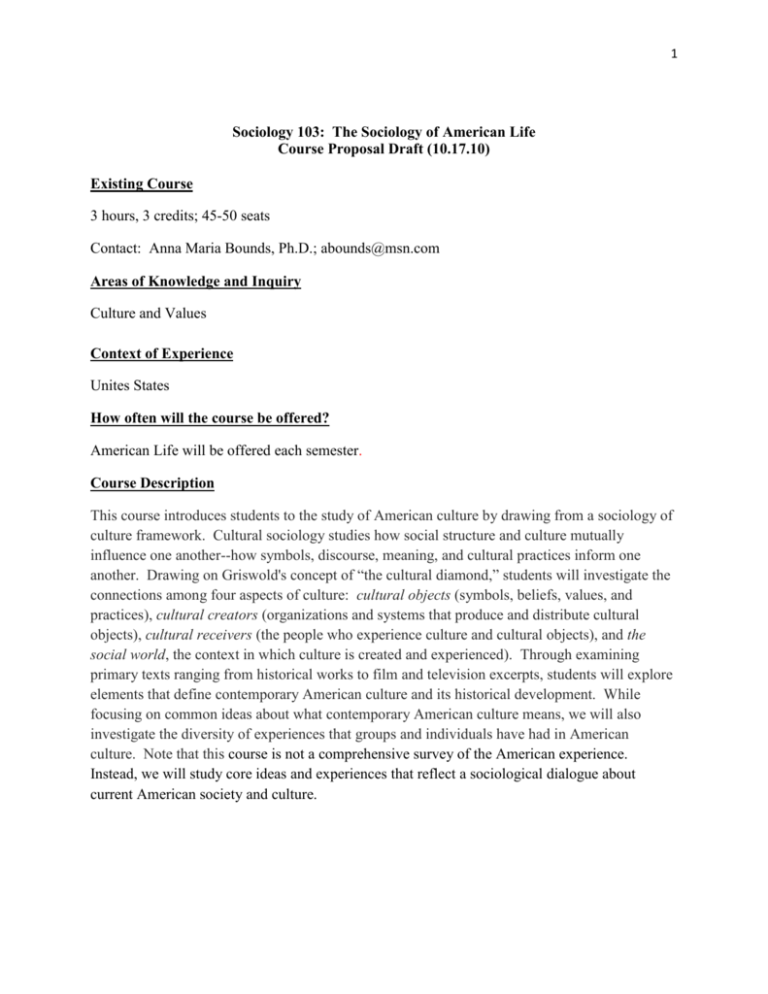
1 Sociology 103: The Sociology of American Life Course Proposal Draft (10.17.10) Existing Course 3 hours, 3 credits; 45-50 seats Contact: Anna Maria Bounds, Ph.D.; abounds@msn.com Areas of Knowledge and Inquiry Culture and Values Context of Experience Unites States How often will the course be offered? American Life will be offered each semester. Course Description This course introduces students to the study of American culture by drawing from a sociology of culture framework. Cultural sociology studies how social structure and culture mutually influence one another--how symbols, discourse, meaning, and cultural practices inform one another. Drawing on Griswold's concept of “the cultural diamond,” students will investigate the connections among four aspects of culture: cultural objects (symbols, beliefs, values, and practices), cultural creators (organizations and systems that produce and distribute cultural objects), cultural receivers (the people who experience culture and cultural objects), and the social world, the context in which culture is created and experienced). Through examining primary texts ranging from historical works to film and television excerpts, students will explore elements that define contemporary American culture and its historical development. While focusing on common ideas about what contemporary American culture means, we will also investigate the diversity of experiences that groups and individuals have had in American culture. Note that this course is not a comprehensive survey of the American experience. Instead, we will study core ideas and experiences that reflect a sociological dialogue about current American society and culture. 2 The course has two broad goals: To explore the complexities and contradictions underlying American culture, studying how (or if) disparate Americans have shaped a shared American identity and culture; and To discover how different concepts of identity (individual, community, cultural, and national) are formed. With these objectives as a foundation, students will be encouraged to think critically about the ideas and experiences that influenced the evolution of American culture. Primary focus will be on close textual readings, critical thinking, class discussion, and cultural analysis. The course seeks to answer questions such as: How do sociologists conceptualize and explain culture? And, how do sociological theories help us to understand different perspectives of American culture? Applying sociological theories of culture to selected texts will enable students to interpret the context of the messages, meanings, experiences, and ideas of American culture. This course satisfies three PLAS requirements. It fulfills the Culture and Values (CV) Area of Knowledge because we examine how social forces influence American culture and the role that culture plays in exerting or resisting regimes of dominance. The course also satisfies the United States (US) Context of Experience requirement because it focuses on American culture and values. The course, American Life, includes the following units: nationalism and civil religion, race and ethnicity, gender and sexuality, culture and consumerism, social and economic class, and media culture. To facilitate learning within each unit, students will study both a current topic and a set of sociological readings that help students understand the issue in its social context. Students will also discuss a primary text that reinforces key themes. For example, in the social and economic class unit, students will be given a profile of the American economy to familiarize students with its state (economic indicators and forecasts). To understand important debates about social and economic issues, such as class in the U.S, students will be introduced to a sociological framework that guides them through exploring concepts such as the underclass and the impact of inequalities. Students will also watch a documentary that reveals the hardships that the working poor face in the US. Justification The course satisfies the Perspectives Criteria 1-3 and the optional criteria 5, 6, and 8. Criteria 1-3: The course meets Criteria 1-3 in the following ways: 3 In this course, students learn how Sociology contributes to understanding how the concept of American culture influences community, national, and individual identity through several approaches. First, through readings and studying primary texts (such as films, music, and art), students discover how sociological theory allows them to explore how values and ideas associated with American culture are developed and change over time. Writing assignments and class presentations encourage students to reflect on their own experiences as Americans or their perceptions of Americans. Through this combination of learning methods, students are reminded of their own agency by learning that society creates the conditions of our lives and that there is possibility for positively changing the world and promoting democracy. Mastery of these goals will be assessed through examinations (a mid-term and a final) and a research paper. Criteria 5: Through examining the diverse experiences of different groups in American culture, students reflect on how the social construction of identities and dominant values are developed and reinforced. Criteria 6: Students engage in active inquiry through assignments such as group presentations in which they present key themes and examples of a topic and a research essay based on their respective interests in American culture. Students will also be challenged to determine the suitability of specific sociological theories in analyzing elements of culture. Criteria 8: Students will use a variety of primary texts to study how these texts communicate ideas about American culture. Examples of primary texts to be discussed in the course include historical documents, speeches, film and television excerpts, music, and advertisements. Course Materials, Assignments, and Activities Readings: Required Texts Cultures and Societies in a Changing World by Wendy Griswold (3rd Edition) Readings for Sociology edited by Garth Massey (Sixth Edition) Additional Readings will also be distributed in class. 1) Griswold: Chapter 1 “Culture and the Cultural Diamond”. This chapter introduces examining culture from a sociological perspective. It introduces the concept of a “cultural diamond” to study connections among four elements of culture: cultural objects, cultural creators, cultural receivers, and the social world. 4 2) Williams, Ray. 1976. Keywords: A Vocabulary of Culture and Society. New York: Oxford U. Press. Pp. 76-82. This work traces the historical origins and classifications of the word “culture”. 3) Film: Pleasantville Excerpt. In this excerpt, the main character, a mother and wife, recognizes that she is no longer satisfied with how culture defines her role. 4) Tocqueville: Democracy in America Part 1 (Chapters 1 and 2). These chapters are a collection of his observations about the strengths and weaknesses of American democracy. 5) U.S. Constitution Excerpt (The Bill of Rights). This founding document outlines the fundamental rights of US citizens. 6) Griswold: Chapter 2 “Cultural Meaning”. This chapter provides an overview of the relationship between culture and meaning in sociological thought. It traces the understanding of culture according to Marxist theory, Functionalism, and Weber. 7) Bellah, R. “Civil Religion in America.” Through analyzing a speech by President Lincoln and discussing the significance of the Arlington National cemetery, he outlines the elements of American civil religion. These elements include the perception of a God based on law and moral order, perseverance, tolerance, and equality. 8) 30 Days Episode (Muslims in America). A young white Christian lives in a Muslim community for one month to better understand the religion and culture. 9) Griswold: Chapter 3 “Culture as a Social Interaction”. This chapter discusses culture as a social creation through Durkheim’s study of the role of religion as a social bond and as an important mechanism for interaction. 10) Montemurro, B. “Deviance and Liminality”. This essay examines how moving from one master status to another is a means for a brief exploration of socially scripted deviance. 11) Ferna, E. W. and R. A. Ferna “A Look Behind the Veil”. This essay challenges Western readers to re-think their perceptions of Muslim women. 12) Bellah et al. “Religious Community and American Individualism”. This essay discusses the distinction between belonging and believing in American worshippers. 13) Hosteler, J. “Amish Society”. This essay examines how adherence to a simple lifestyle reflects the religious convictions of the Amish community. 14) Eyes on the Prize Excerpt. This documentary chronicles the American Civil Rights movement; this excerpt shows the training of non-violent protesters and their efforts. 5 15) 30 Days Episode (Border Guard). An individual with anti-immigration views lives with a family of illegal immigrants for one month to better understand their position. 16) Griswold: Chapter 5 “Identities, Problems, and Movements”. This chapter discusses the constructions of collective identity, social problems, and social movements. 17) Walton, A. “My Secret Life as a Black Man”. This article introduces the concept of “cultural markers” that others use to define, evaluate, and interact with one another. 18) Ardizzone, H. and E. Lewis. “Love and Race Caught in the Public Eye”. This essay examines the impact of racial prejudice on love and marriage. 19) Rodriguez, R. “Go North, Young Man”. This essay discusses the importance of immigrants in global society as they integrate and assimilate in different cultures. 20) Waters, M.C. “Optional Ethnicities: For Whites Only”. This essay discusses the differences and tensions between those who can move between ethnic groups or nationalities and those who do not have this freedom. 21) 30 Days Episode (Understanding Homosexuality). In this episode, a heterosexual Christian man lives in San Francisco with a homosexual roommate to better understand the gay community. 22) Griswold: Chapter 8 “Culture and Power”. This chapter discusses the relationship between culture and power. It focuses on identity politics, the aesthetics of power, and political acts as cultural objects. 23) Messner, M. “Boyhood, Organized Sports, and the Construction of Masculinities”. By analyzing interviews of thirty male former athletes, this study examines the way sports focus and define masculinity as well as how social class impacts relationships beyond the playing field. 24) Bettie, J. “Women without Class: Chicas, Cholas, Trash, and the Presence/Absence of Class Identity”. This study explores how a group of high school females finding and presenting identities that express different interpretations of femininity and reveals the interconnections between ethnicity, gender, and class that reinforce social inequality. 25) Hull, K. “Marriage, Culture, and Law”. Through examining same-sex marriage ceremonies and interviewing the couples, the essay explores the cultural meaning of marriage and the political debate surrounding the question of who can legally marry. 26) 30 Days Episode (Living on Minimum Wage). In this episode, an affluent young couple lives for one month as minimum wage workers in an American city. 6 27) New York Times Series on Class. This newspaper series explores ways that class, defined as a combination of income, education, wealth and occupation, influences success in American society. 28) Ehrenrich, B. “Nickel and Dimed: On (Not) Getting By in America”. This article examines the challenges of the lives of the working poor. 29) Wilson, W. J. Excerpt from “When Work Disappears: The World of the New Urban Poor”. This article analyzes the historical emergence of ghettos as sites that reinforce chronic urban employment and its related social problems as well as the impact of ineffective labor-market policies that hold down minimum wage. 30) Gans, H. “Uses of the Underclass in America”. Through the use of functional analysis, this essay argues that the lives and work of the poor benefit the nonpoor in ways that are unrecognized in American culture such as serving a displacement function, the poor being accused of causing social problems which they did not cause and serving as cathartic objects for the wealthy to unload their problems on. 31) Who the [Bleep] is Jackson Pollock? Through tracing how the art world responds to a discovery of a possible new Jackson Pollock painting, this examines the conflict between different paradigms and interpretations of what classifies as “art”. 32) Griswold: Chapter 4 “Production, Distribution and Reception of Culture”. This chapter discusses the culture industry system and its effect on audiences and taste cultures. 33) Peterson, R.A. and R. M. Kern. (1996) “Changing Highbrow Taste: From Snob to Omnivore.” American Sociological Review 61: 900-907. This article analyzes the historical shift of elites from engaging in mainly fine arts activities to participating in a broad mix of both fine arts and popular culture forms of entertainment. This shift in taste is attributed to changes in status-group politics influenced by changes in social structures, values, art world dynamics, and generational conflict. 34) Griswold: Chapter 7 “Culture and Connection”. This chapter explores the impact of media revolutions on culture communities and the cultural impact of the Internet. 35) Ellison, N., Steinfield, C. and C. Lampe. (2007) “The Benefits of Facebook ‘Friends’: Social Capital and College Students Use of Online Social Networking Sites” Journal of Computer-Mediated Communication . This survey research study examines the relationship between use of Facebook, an online social network site, and the creation and maintenance of social capital by undergraduates. Regression analyses suggest a strong association between Facebook use and the three types of social capital. Facebook usage was found to correspond to measures of psychological well-being, suggesting that it might provide greater benefits for users experiencing low self-esteem and low life satisfaction. 7 Essay Assignment: This essay offers students the opportunity to delve into a topic addressed in class or a research area that has been introduced in the readings but has not been discussed in the course. Students may also choose your own topic. Instructor approval of topics is required. The essay will be between 6-8 pages (excluding the bibliography); students will also follow the standards of academic writing (either ASA or MLA). Exams: There will be two non-cumulative examinations, a mid-term and a final. They will be a combination of multiple choice, True/False, and short answer examinations. Group Presentations: Each class period, a group of students will be assigned to introduce key themes of the readings and a cultural artifact that reflects the topic. The artifact can be anything that you believe represents the particular concept. Cultural artifacts include media articles and images as well as selections from works such books, music, and film. For example, when discussing the social construction of sexual identity, a children’s book that reinforces dominant perceptions of male and female roles would be an important tool for discussion. Group size will be determined according to class size. Assessment PLAS courses are evaluated each semester by senior sociology department faculty who conduct teaching observations of instructors teaching PLAS courses. This evaluation also includes a review of the course syllabus to check with conformity to PLAS criteria. Administration This course will be taught by full-time and adjunct faculty members. The department’s curriculum committee will oversee PLAS courses and approve course modifications.

